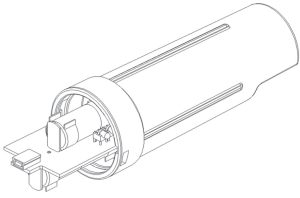ONSET U-DTW-1 HOBO Waterproof Shuttle User Manual
HOBO Waterproof Shuttle
U-DTW-1
Included Items:
- USB cable
- Set of couplers;
- For UA Pendant (COUPLER2-A)
- For U20 Water Level (COUPLER2-B)
- For U20L Water Level, U22 Water Temp Pro v2, U24 Conductivity, and U26 DO (COUPLER2-C)
- For UTBI TidbiT v2 (COUPLER2-D)
- For U23 HOBO Pro v2 (COUPL
Required Items:
- HOBOware Pro 2.2 or later
- Compatible logger and matching coupler
The HOBO Waterproof Shuttle performs several major functions:
- Reads out all logger information (serial number, deployment number, data, etc.) from loggers in the field for transfer to host computer, and stores each logger’s data in a “bank”
- Nonvolatile memory preserves data, even if batteries are depleted
- Relaunches the logger, resetting the logger’s time to the shuttle’s time and synchronizing the logging interval on relaunch
- Can be used as an optic-to-USB base station
- Can be used to read out and relaunch loggers underwater
Although the HOBO Waterproof Shuttle is easy to use, Onset strongly recommends that you spend a few minutes reading this manual and trying out the procedures described here before taking the shuttle into the field.
Important: Remove the batteries from the shuttle if it will be out of service for more than a month at a time to prevent the batteries from leaking and damaging the shuttle. Reinstall them just before you begin using the shuttle again as described in Replacing the Shuttle’s Batteries.
Specifications
| Compatibility | All HOBO U-Series loggers with optic USB. Not compatible with the HOBO U-Shuttle (U-DT-1). |
| Data Capacity | 63 logger readouts of up to 64K eac |
| Operating Temperature | 0° to 50°C (32° to 122°F) |
| Storage Temperature | -20° to 50°C (-4° to 122°F) |
| Wetted Materials | Polycarbonate case, EPDM o-rings and retaining loop |
| Waterproof | To 20 m (66 feet) |
| Time Accuracy | ±1 minute per month at 25°C (77°F); see Plot A |
| Logger-to-Shuttle Transfer Speed | Reads out one full 64K logger in about 30 seconds |
| Shuttle-to-Host Transfer Speed | Full shuttle offload (4 MB) to host computer in 10 to 20 minutes, depending on computer |
| Batteries | 2 AA alkaline batteries required for remote operation |
| Battery Life | One year or at least 50 complete memory fills, typical use |
| Weight | 150 g (4 oz) |
| Dimensions | 15.2 x 4.8 cm (6.0 x 1.9 inches) |
 |
The CE Marking identifies this product as complying with all relevant directives in the European Union (EU). To maintain CE compliance, this product must be used with the supplied USB cable or equivalent (less than 3 m long). |
Plot A 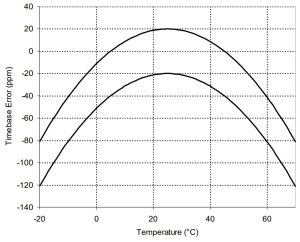
HOBO Waterproof Shuttle Features
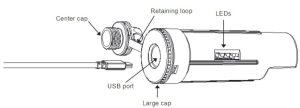
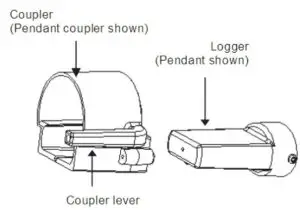
Preparing to Go on Location
Before using the shuttle for the first time, you must launch it with HOBOware Pro 2.2 or greater. You must also launch any compatible loggers that were last launched with an earlier version of HOBOware Pro, or have never been launched at all.
- Use HOBOware Pro 2.2 or greater to launch each logger you wish to read out and relaunch with the shuttle later. (Read “Using the shuttle as a base station” for instructions if you do not have another base station for the loggers.) The shuttle cannot relaunch loggers that were last launched with an earlier version of HOBOware Pro. (You only have to do this once for each logger.)
- Plug the large end of a USB interface cable into a USB port on the computer. (Avoid using a USB hub, if possible.)
- Unscrew the center cap on the shuttle. If the cap is too tight to loosen by hand, insert a screwdriver through the lanyard hole and rotate counterclockwise until the cap is loosened.
- Plug the small end of the USB interface cable into the USB port in the shuttle. (If the shuttle has never been connected to the computer before, it may take a few seconds for the new hardware to be detected.)
- Follow the instructions in the HOBOware User’s Guide to access the Manage Shuttle dialog. Make sure the battery level is good, and change the batteries now if they are weak.Important: If you change or remove the batteries, the shuttle’s clock will stop, and the shuttle will not read out loggers again until you relaunch it in HOBOware.
- If you are using the shuttle for the first time, launch the shuttle as described in the HOBOware User’s Guide. Launching synchronizes the shuttle’s clock to the host computer and initializes the shuttle’s header.Important: The shuttle’s clock is used to set the logger’s clock at relaunch. For most accurate results, make sure the host computer’s clock is correct before launching the shuttle. If you need to adjust the computer’s clock, quit HOBOware, set the computer’s clock, then reopen HOBOware and launch the shuttle.
- If you have used the shuttle before, make sure there are enough banks available to accommodate the loggers you plan to read out.
- Disconnect the USB cable from the shuttle and replace the center cap securely.
Reading Out and Relaunching Loggers in the Field
After you have ensured that the shuttle’s batteries are good, there is sufficient memory available, and the shuttle’s clock is synchronized, follow these steps to read out and relaunch a logger in the field:
- Make sure the shuttle’s large cap and center cap are closed securely. Tighten the center cap until it is just flush with the large cap, or until the O-ring is no longer visible.
- Make sure the communication end of the shuttle is clean. Attach the correct coupler for the logger, and ensure that it is seated properly.
- Insert the logger into the coupler, following the instructions that came with the coupler.
- Momentarily press the coupler lever (pressing hard enough so the lever bends).
 Readout should begin immediately. The amber LED blinks continuously while readout and relaunch are in progress. Do not remove the logger when the amber LED is blinking.
Readout should begin immediately. The amber LED blinks continuously while readout and relaunch are in progress. Do not remove the logger when the amber LED is blinking. - After reading out the logger, the shuttle synchronizes the logger’s clock to the shuttle’s internal clock and relaunches the logger, using the description, channels to log, logging interval, and other settings that are already in the logger. (If the logger was launched with multiple logging intervals, the final defined logging interval will be used.) The logger is launched with a slight delay that causes its readings to be synchronized with those of the previous deployment, as shown in the following diagram.
 Important: If the logger was launched with multiple logging intervals, there will be no synchronizing delay. The logger will start immediately with the last defined logging interval.
Important: If the logger was launched with multiple logging intervals, there will be no synchronizing delay. The logger will start immediately with the last defined logging interval. - When the relaunch has completed, the green LED blinks for 15 minutes, or until you momentarily press the coupler lever to stop it (press hard enough so the lever bends). If the red LED blinks instead, there was an error, and the logger may have stopped. Refer to “Troubleshooting” in this manual for details.
- Remove the logger from the coupler
Checking Shuttle Status in the Field
The shuttle’s memory has 63 “banks.” One logger readout can be stored in each bank. To check the shuttle’s memory and batteries in the field, remove the logger and press the coupler’s lever for at least three seconds (pressing hard enough so the lever bends). When you release the lever, the green LED blinks once for each unoccupied bank in the shuttle’s memory. (Press the lever momentarily to stop the blinking, pressing hard enough so the lever bends.)
If the shuttle’s batteries are running low, all of the shuttle banks are full, or the clock has not been set, the red LED blinks. (Press the lever momentarily to stop the blinking, pressing hard enough so the lever bends) Use HOBOware to check the shuttle’s battery level, available memory, and clock. You may need to change the batteries, or offload the datafiles to the host computer and delete them from the shuttle to free up memory before you can continue reading out loggers.
Offloading Data to the Host Computer
You can offload the data stored in the shuttle even when the batteries are depleted. Take the following steps:
- Connect the shuttle to a host computer running HOBOware.
- Follow the instructions in the HOBOware User’s Guide to offload the new datafiles or access the Manage Shuttle dialog. The Manage Shuttle dialog shows you how many banks are occupied, and whether they have already been offloaded and saved to the host computer.
- Offload and save data from the banks of your choice. Refer to the HOBOware User’s Guide for details on saving datafiles offloaded from the shuttle.
- Review the list of banks and delete any that are no longer needed. Make sure the battery level is good, and change the batteries now if they are weak. (If you change the batteries in the field, the shuttle’s clock will stop, and the shuttle will not read out loggers.) Update the shuttle’s clock, if necessary.
- When finished, disconnect the shuttle from the computer and close the center cap securely.
Using the Shuttle as a Base Station
You can use the shuttle as a base station for any U-Series logger with an optic USB interface. (This function is available even when the batteries are depleted.) To use the shuttle as a base station:
- Connect the shuttle to the host computer running HOBOware.
- Attach a compatible logger and coupler.
- Momentarily press the coupler’s lever (pressing hard enough so the lever bends).
- The amber LED blinks momentarily, then the green LED should glow steadily to indicate that the logger is ready to communicate with HOBOware. (If the red LED blinks instead, the logger was not found. Make sure the logger and coupler are aligned and seated properly, and that there is no dirt or strong sunlight interfering with communications.)
- When finished, remove the logger from the coupler. Thegreen LED stops glowing when you disconnect the logger or the USB cable.
Important: The Waterproof Shuttle cannot be used as a base station with Pendant logger models UA-001 and UA-003 (including rain gauges RG3 and RG3-M) with serial numbers less than 988278. These loggers require a BASE-U-1 for communication with the host computer.
Indicator Lights
Green “OK” LED
The green “OK” LED blinks when HOBOware recognizes it as a base station; when it finishes reading out and relaunching a logger; and when you press the coupler lever to check the shuttle’s status (see “Checking shuttle status in the field” for details). Momentarily press the coupler lever to stop the blinking (pressing hard enough so the lever bends).
The green LED glows steadily when the shuttle is being used as a base station.
Amber “Transfer” LED
The amber “Transfer” LED blinks when the shuttle is reading out a logger and relaunching it. Do not remove the logger when the Transfer light is lit.
Red “Fail” LED
The red “Fail” LED blinks whenever the shuttle encounters an error condition. Refer to “Troubleshooting” for details.
All LEDs
All LEDs blink in unison when the shuttle has just been powered up, either by installing fresh batteries or (if batteries are not installed) by connecting to the computer’s USB port.
Troubleshooting
This section describes problems you may encounter while using the shuttle.
Shuttle is not recognized by host computer
If HOBOware does not recognize the shuttle when you connect it to the computer, simply disconnect and reconnect the shuttle.
Red “Fail” LED blinks
The red “Fail” LED blinks (for 15 minutes, or until you press the coupler lever, pressing hard enough so the lever bends) whenever the shuttle encounters an error. There are several conditions that might cause an error
- Shuttle is full: If the red LED blinks when you try to read out a logger, check whether all of the banks are full, as described in “Checking shuttle status in the field.” Or, use HOBOware to check the shuttle’s memory.
- Shuttle batteries are low: If you cannot read out any loggers at all, check the logger’s status, as described in “Checking shuttle status in the field,” or use HOBOware to check the shuttle’s batteries. The batteries may simply need to be replaced.
- Compatibility: The shuttle cannot read out or relaunch loggers that were last launched from HOBOware Pro prior to version 2.2. You will need to read out these loggers on the host computer and relaunch them in HOBOware Pro 2.2 or greater before you can use them with the shuttle.
- Shuttle clock is not set: The shuttle has experienced a power failure that caused the clock to reset. You must use HOBOware to offload the files that are already on the shuttle, then relaunch the shuttle before you can read out another logger.
- Can’t communicate with logger: Remove the logger and coupler. Inspect them and the shuttle to ensure that all are free of dirt that could block the optic communication sensor. Carefully reassemble the shuttle, coupler, and logger, and make sure they are all seated properly. Shield the shuttle from strong sunlight, if applicable, which can interfere with optic communications.
- Other logger problems: If you can read out some loggers but not others, or if you cannot read out any loggers even with fresh batteries in the shuttle, check the loggers in HOBOware. Make sure their batteries are at acceptable levels and that there is no “corrupted header” message.
Amber “Transfer” LED stays on without blinking
The amber light is magnetically activated when you press the coupler lever. If it glows steadily at any other time, the magnet in the lever may be too close to the magnetic switch in the shuttle, or another strong magnet may be present. Try bending the lever away from the coupler to reduce the magnet’s effect.
LEDs do not function
If the LEDs are not functioning at all, the batteries may be completely exhausted. To test this, attach the shuttle to the host computer and check the battery level. The shuttle should be able to communicate with the host computer, blink its LEDs normally, and perform as a base station even when the batteries are missing or depleted.
Replacing the Shuttle’s Batteries
The shuttle’s batteries should last about one year or at least 50 complete memory fills in typical conditions. When the shuttle’s batteries run low (2.2 V or less), any logger data that is already in the shuttle will remain safe, but the shuttle will not read out another logger until its batteries are replaced.
To avoid battery problems, always check the shuttle’s batteries in HOBOware before going into the field, and replace them if needed. In addition, remove the batteries if the shuttle will be out of service for more than a month at a time to prevent the batteries from leaking and damaging the shuttle. Reinstall them and relaunch the shuttle just before you begin using it again.
To change the shuttle’s batteries:
- Work over a clean surface to provide a safe platform for the disassembly.
- Unscrew the center cap on the shuttle. If the cap is too tight to loosen by hand, insert a screwdriver through the lanyard hole and rotate counterclockwise until the cap is loosened.
- Use the center cap to help you carefully pull the rubber loop free of the large cap. The large cap cannot be removed while the rubber loop is in place.

- Turn the large cap counter-clockwise slightly, then pull it off.

- Turn the shuttle over and tap it gently. The circuit board should slide into your hand.

- Remove the old batteries and install two new ones in the correct orientation. Both batteries should be turned the same way, with their positive ends facing the USB port on the board. (When the second battery makes contact, all of the shuttle’s LEDs will blink in unison.) It is recommended that you replace the desiccant (DESICCANT2) when replacing the batteries.
- Put the board back into the case, taking care not to bend the communication LEDs. Align the circuit board with the runners in the case. The USB port should face the open end of the shuttle, and the LEDs should show through the window on the label.
- Close the shuttle’s case. Line up the tabs on the large cap with the slots on the case, press gently, and turn slightly clockwise until the large cap is closed securely.
- Replace the rubber loop and center cap. Tighten the center cap until it is just flush with the large cap, or until the O-ring is no longer visible.
- Using HOBOware, offload any datafiles that are on the shuttle and launch the shuttle before going into the field again. The shuttle will not read out and relaunch loggers until the clock has been synchronized.
![]() WARNING: Do not install batteries backwards, recharge, put in fire, expose to extreme heat, or mix with other battery types, as the batteries may explode or leak. Contents of an open or leaking battery can cause chemical burn injuries. Replace all used batteries at the same time. Recycle or dispose of batteries according to applicable federal, state, and local regulations.
WARNING: Do not install batteries backwards, recharge, put in fire, expose to extreme heat, or mix with other battery types, as the batteries may explode or leak. Contents of an open or leaking battery can cause chemical burn injuries. Replace all used batteries at the same time. Recycle or dispose of batteries according to applicable federal, state, and local regulations.
[xyz-ips snippet=”download-snippet”]

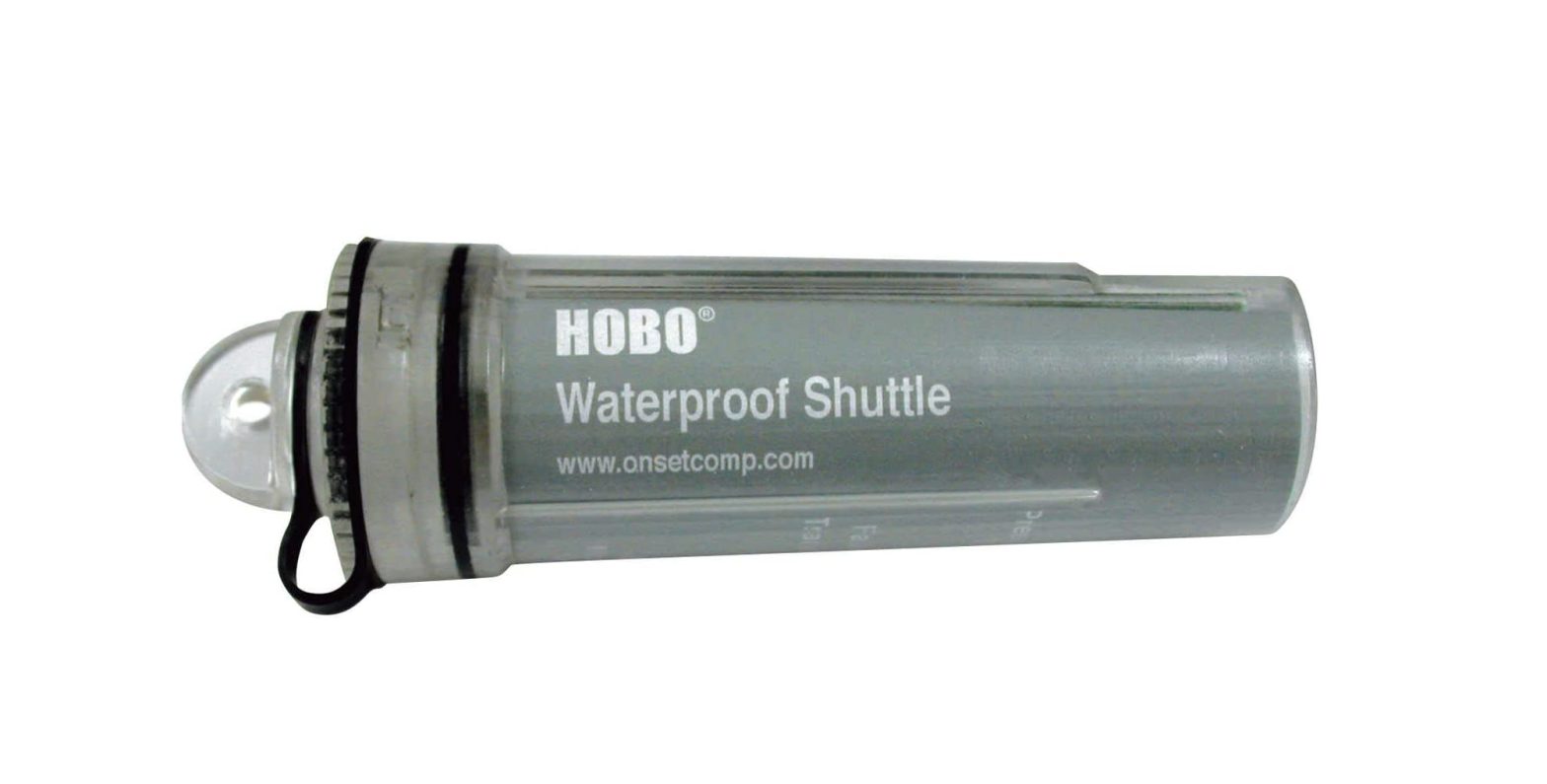
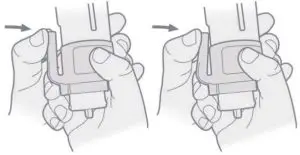 Readout should begin immediately. The amber LED blinks continuously while readout and relaunch are in progress. Do not remove the logger when the amber LED is blinking.
Readout should begin immediately. The amber LED blinks continuously while readout and relaunch are in progress. Do not remove the logger when the amber LED is blinking.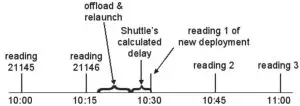 Important: If the logger was launched with multiple logging intervals, there will be no synchronizing delay. The logger will start immediately with the last defined logging interval.
Important: If the logger was launched with multiple logging intervals, there will be no synchronizing delay. The logger will start immediately with the last defined logging interval.

